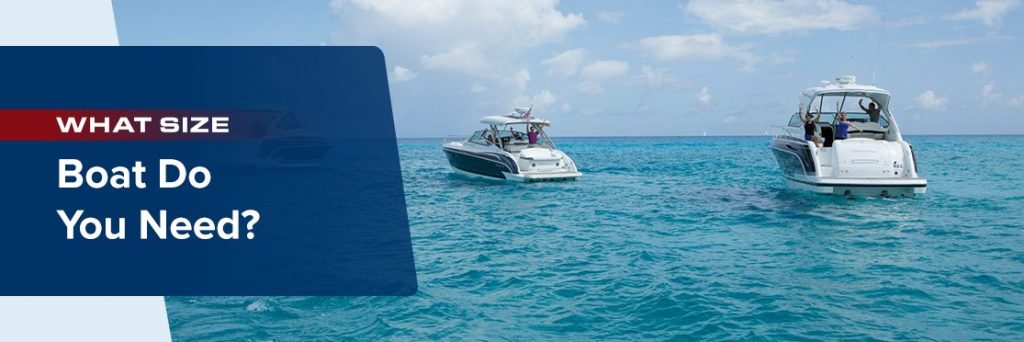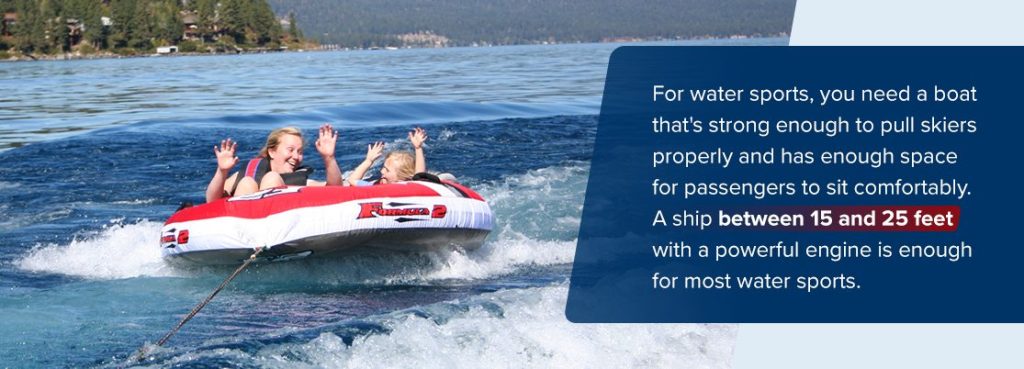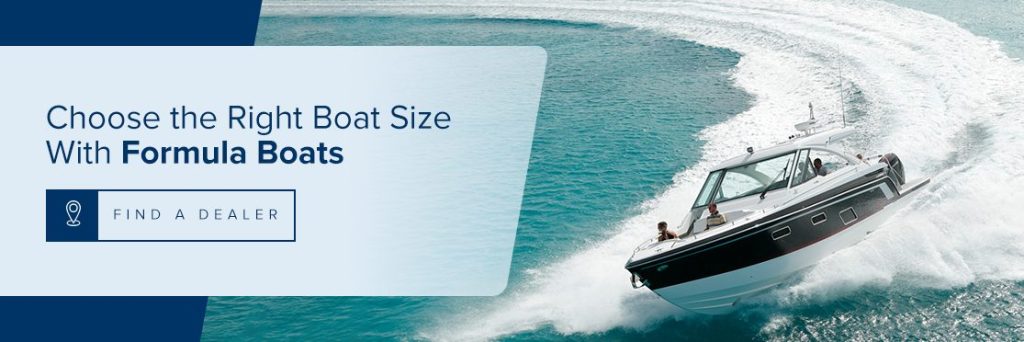
Several factors determine the size of the boat you should buy, including how you’ll use the boat, how many people will be on it, the type of boat and where you’ll be using it. It’s key to consider all of these aspects for the best and safest boating experience. Browse our guide below to determine what size boat you’ll need.
Boat Size According to Purpose
The purpose of your boat will directly influence its size. If you’re going fishing, you’ll need more space for equipment, while overnight and longer cruising trips need more comfortable cabins and storage space. Here are some of the best sizes for boats based on how you’ll be using them:
Fishing
There are three main ways to go fishing — offshore, inshore and on bays and lakes. Fishing boat sizes can vary between each type of fishing due to weather and water conditions. Here are the best boat sizes for each:
- Offshore fishing: The rough weather conditions and heavy ocean waves require a robust, sturdy boat. You also need enough space for fishing equipment, accessories and storage. To go offshore, you need a boat that’s 30 feet long or larger. Smaller fishing boats can be thrown around on rough waves, creating a dangerous and uncomfortable experience for you and other passengers.
- Inshore fishing: This type of fishing requires a boat that can easily navigate shallow water and fit into hard-to-reach locations. In most cases, a 17- to 22-foot-long boat is ideal for inshore fishing. Smaller ships can easily cut around tight bends and journey through shallow waters without impacting passenger comfort.
- Bay and lake fishing: To go fishing on bays and lakes, you need a versatile boat to handle the different weather and water conditions of the various bodies of water. It’ll also need to be big enough to be comfortable for friends and family to enjoy cruises. A boat between 20 and 30 feet is often ideal for bay and lake fishing.
Cruising and Pleasure Sailing
Cruising and pleasure sailing boats should include comfortable seating and a sizeable deck area. If you want to go on longer cruises or overnight trips, you’ll need a boat with a cabin, galley and toilet.
Cruising boats are generally between 20 and 30 feet long when used inshore. For offshore cruising and sailing, you’ll need a vessel that’s 30 feet or longer. This size will give you the space for additional amenities while being sturdy enough to handle ocean conditions.
Water Sports

For water sports, you need a boat that’s strong enough to pull skiers properly and has enough space for passengers to sit comfortably. A ship between 15 and 25 feet with a powerful engine is enough for most water sport boats.
Boat Size by Passenger Number
Another significant factor in choosing a boat size is how many people will be on the vessel. The more passengers, the bigger the boat. For example, a family of six will need a boat that’s at least 20 feet long, while a family of three only needs a 12-foot-long boat.
You must also allow space for people to move around freely. It’s a good idea to buy a boat a bit bigger than you think you need to enable passengers to move around comfortably. Below is a simple boat size chart based on passenger numbers:
| number of passengers | average Boat size |
|---|---|
| 3 | 12 feet |
| 4 | 15 feet |
| 5 | 18 feet |
| 6 | 20 feet |
| 8 | 24 feet |
| 10 | 26 feet |
| 12 | 27 feet |
| Over 13 | 30 feet or more |
These are average boat sizes based on the number of passengers. It’s also essential to check the capacity of a boat before buying it. The capacity will tell you how many people can safely be on the boat. Depending on the model and type of vessel, the capacity may differ slightly from the numbers above as seating and deck arrangements vary.
Generally, boat capacity is based on this calculation — vessel length (feet) x vessel width (feet) ÷ 15 = boat capacity. However, this calculation is quite basic and doesn’t account for other factors such as seating, storage space and the weight of any equipment and supplies you bring onboard. Always follow the boat capacity limit and ensure you buy a boat that’s big enough to accommodate your family and friends safely.
Other Factors Affecting Boat Size
Other than how you’ll use your boat and how many people you plan to have on it, several factors influence the boat size you need. These include:
- Trailer and storage: Longer boats need more storage space when not on the water and stronger vehicles to trailer them safely.
- Experience level: If you’re just starting as a boater, a smaller boat will be easier for you to operate. Larger boats require more experienced and skillful handling, and you may need to take classes to operate bigger vessels safely.
- Dock space: Due to limited space, marinas and harbors may have size restrictions. Always check the slip space available at your nearest dock to ensure it has room for your boat.
- Budget: The larger the boat, the more expensive it is. The size can also extend to storage and maintenance options, so research all the costs involved before buying a boat.
- Time on water: If you’re going to live on your boat or take long trips, you’ll need a larger boat that has space for sleeping, relaxing, storage, cooking and at least one bathroom. A smaller boat is enough for short day trips.
- Boat type and model: The capacity of a boat will vary based on its model and type. A bass boat of 20 feet may only be able to hold five people, while a pontoon boat of the same size can hold up to 13 people. This is because seating and deck arrangements on each boat are different.
Choose the Right Boat Size With Formula Boats

There are many points to consider when finding the right boat size for your needs. Formula Boats has a comprehensive range of boats for you to choose from, and we can customize boats to suit your needs.
Find the right boat today by locating a Formula Boats dealer near you or shopping our catalog!
